Best Psi For Mountain Bike (2024 Update)
Riding a mountain bike through rough terrain and up steep hills requires tires that can handle plenty of impacts without losing air pressure. While mountain bike tires typically have thick casings for durability, choosing the right PSI is crucial for maximizing performance and avoiding flats. When shopping for the best PSI for your mountain bike, there are a few key factors to keep in mind.
First, consider the type of trails you’ll be riding. Lower pressure gives tires more grip and cushion for riding over rocks and roots, while higher pressure rolls faster on paved or hard-packed dirt trails. Heavier riders will need more PSI to avoid pinch flats and rim damage from impacts. The width of the tire also affects ideal pressure—wider tires can safely run lower pressures.
Mountain bike tire pressure is largely a matter of personal preference and finding the ideal balance of speed vs. control for your riding style and local trail conditions. Too high and the ride will feel harsh and jarring. Too low and you risk pinch flats, rim strikes and sluggish acceleration.
What’s the ideal PSI sweet spot for mountain bike tires? How much does rider weight impact pressure needs? What’s the best way to accurately gauge pressure while out on the trails? As a beginner, what pressures should you run to avoid flats while your skills progress? Discover the answers to these questions and more as we dive into the details of finding the best PSI for your mountain bike’s tires.
10 Best Psi For Mountain Bike
| # | Product Image | Product Name | Product Notes | Check Price |
|---|---|---|---|---|
|
1
|
The product is ideal for adding air pressure to the front fork and rear suspension of mountain, road bikes and motorcycles.
|
|
||
|
2
|
Ideal for inflating bike shocks and rear suspension with a maximum pressure of 400 PSI and no-loss Schrader valve.
|
|
||
|
3
|
This product is ideal for those who want a fast and efficient way of mowing large areas with precision.
|
|
||
|
4
|
The product is ideal for repairing and inflating tires on mountain bikes and road bikes while on the go.
|
|
||
|
5
|
Ideal for inflating various bike tire types with ease, while being compact and durable enough to carry on rides.
|
|
||
|
6
|
It is an ideal portable bike pump for fast inflation of Schrader and Presta valve tires on road, mountain, and electric bikes.
|
|
||
|
7
|
The product is ideal for inflating tires on road and mountain bikes quickly and easily with high pressure and a gauge.
|
|
||
|
8
|
Product [PRO] is ideal for those who want a high-performance zero turn mower at a reasonable price point.
|
|
||
|
9
|
The product is ideal for pumping high pressure into fork and rear suspensions with a nozzle lock to prevent air loss.
|
|
||
|
10
|
Ideal for inflating tires and balls on bicycles, motorcycles, and other sports equipment using both Presta and Schrader valves.
|
|
1. Shockmaster: High-Pressure Pump For Bikes & Motorcycles
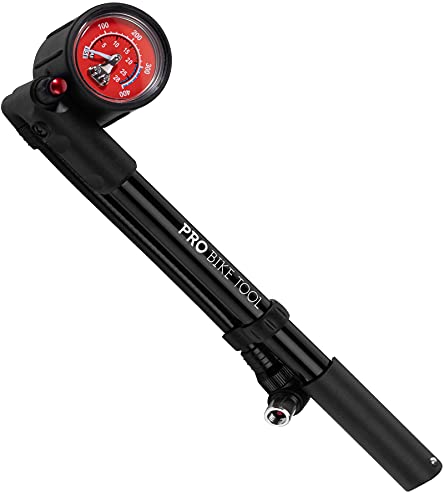
If you're looking for a precision pump that can help you achieve a great ride, look no further than this shock pump. Capable of achieving up to 300 PSI / 20 BAR, it's the perfect tool for fine-tuning the pressure in your suspension, especially if you're into mountain biking or motorcycling.
With its precision calibration, this pump allows you to perfectly tune the travel and damping in your forks and rear shocks, ensuring the ultimate comfort on your ride. What's more, the clear and easy-to-read 1.5" industrial gauge with PSI and Bar readout makes it easy to regulate and adjust the pressure as needed.
But that's not all. This pump also features a fine-tune bleeder button that lets you obtain the exact pressure you need, as well as a 2-stage anti-leak valve head that delivers a secure valve connection when pumping and no air leaks when removed. And with its high-quality CNC machined alloy head and barrel, it's both reliable and lightweight.
Comfortable and easy to use, this pump also features a pull-out T-handle with ergonomic design that ensures pinch-free pumping. And with its 6" swivel hose with pivot mount, it's easy to get things lined up and pump in any angle.
So if you're looking for a pro-quality pump that can help you achieve the perfect ride, look no further than this shock pump. And if you ever have any issues with the product, the manufacturer is happy to provide either a refund or replacement.
2. Beto Mtb Shock Pump – 400 Psi Max!
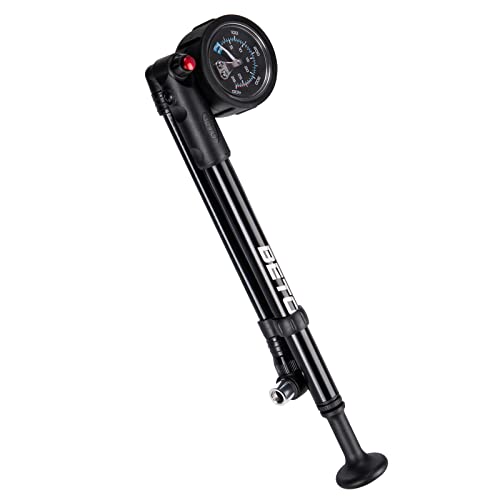
The MTB shock pump from BETO is an essential tool for every avid mountain biker. With over 30 years of experience in bike pump manufacturing, BETO is a well-known and reputable brand in the cycling industry. The pump is designed with an ergonomic handle for extra comfort during use, a 6” swivel hose for easier pumping, and a 1.5” industrial gauge for easy reading.
The pump head is equipped with a 2 Stage Anti-Leak feature that delivers a secure valve connection when pumping, ensuring there are no air leaks when the pump is removed. The pressure gauge measures up to 400 PSI (28 bar) and features a precision manometer with a diameter of 1.5" (approx. 4 cm), making it easy to accurately measure the pressure of your bike's shocks.
The MTB shock pump is incredibly lightweight and compact, making it the perfect tool for bike packing and emergency use on long rides. It won't take up much room in your backpack or hip-bag, and it won't add much weight to your load.
Crafted from high-quality materials, the pump features an all CNC alloy structure and an anti-slip handle, ensuring it is durable and built to last. BETO is a Taiwan-based company that was founded in 1988 and offers a wide variety of bicycle accessories, with a notable specialization in pumps. BETO is a world-renowned brand that produces bike pumps for many well-known brand owners like BELL. Their dedicated R&D team has over 30 years of design and manufacturing experience, ensuring that every cyclist receives the most unique and innovative tool possible.
3. Pro
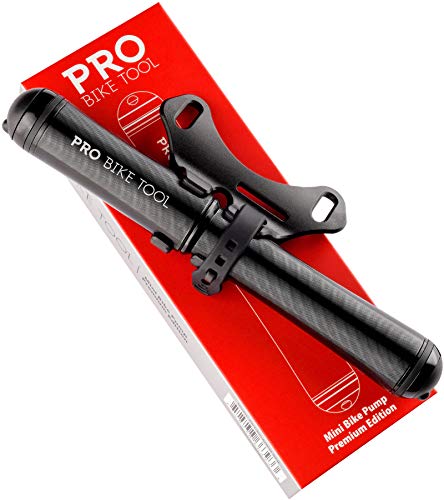
Introducing the new Premium Sleek bicycle air pump with a modern, attractive design that showcases rounded ends and an enhanced exterior. With its high-pressure capacity of up to 100 psi/6.9 bar, this pump is an essential accessory for cyclists and racers seeking optimal performance.
Measuring at only 7.5 inches/19cm long and weighing 4.3 ounces/121g, this super compact, strong and lightweight handheld portable inflator offers the perfect solution for riders who prioritize marginal gains. The pump's durable and precise parts are made from superior quality CNC machined aluminum alloy, ensuring reliable and long-lasting use for a safe and enjoyable ride.
The Presta and Schrader compatibility feature of this high-performance mini bike pump allows for a thread-on valve connection that ensures a tight seal with no air leaks, making it compatible with both Road and MTB bikes.
The pump's safe and secure frame-mounted bracket, with an extra security strap, guarantees that there will be no rattles or lost pump during your ride. Installation of the pump mount requires pre-drilled holes in the bike frame.
4. Acecycle Ultimate Bike Repair Kit
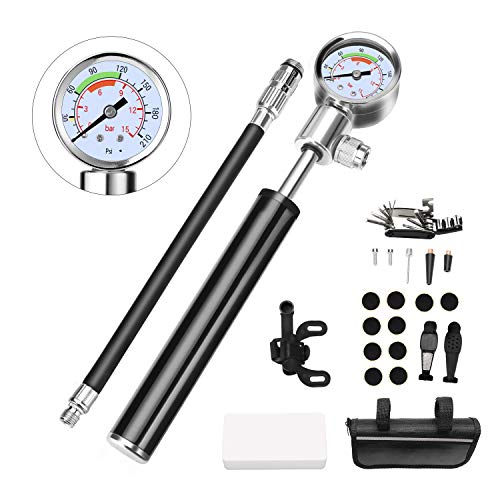
The Multifunctional Repair Kit with 7 in 1 is designed to solve most problems that may arise during your bike ride. This kit includes a 7.8-inch mini bike pump with a gauge that can reach up to 210 PSI, a 16-in-1 repair kit, 10 rubber-free tire patches, 2 bicycle tire crowbars, sports inflatable balls needle, 2 screwdriver heads, and 2 air nozzles. With all these items, you can have a worry-free riding experience.
The main body of the bike pump is made of durable aluminum alloy with better toughness, making it more durable and rust-resistant. The 117g 7.8-inch mini pump is lightweight and comes with a mounting bracket that allows you to carry it anywhere. You can even mount it on your bike.
The Mini Pump has a built-in boost pressure system that allows you to pump up the tires with less force. Its dual valve design head can easily switch between Presta, Dunlop, and Schrader style valves. The secure threaded connection ensures an ultra-tight seal with no air leaks.
The reliable Bicycle Tire Patch Kit is also included in this kit. The pre-bonded tire patch can repair a punctured tire without additional glue. Simply apply the file to the rough part of the tire, and then stick the patch firmly on the tire. It is recommended to use it only for emergency situations.
ACECYCLE offers a 30-day free return for all their products. If you have any questions during the use of the product, do not hesitate to contact their customer service staff. They will reply to your email within 24 hours and provide quality after-sales service. Thank you for choosing ACECYCLE.
5. Minipro Pump – Your Ultimate Bike Companion
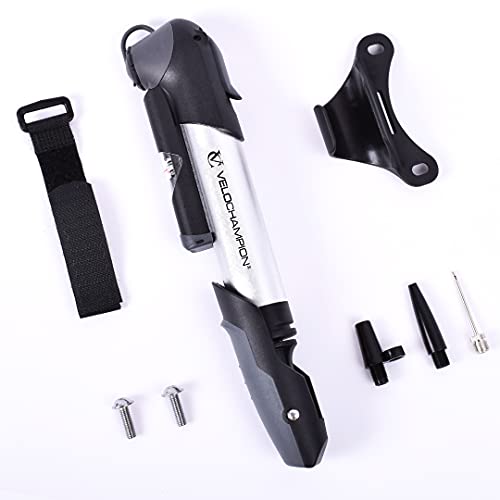
The VeloChampion pump is a versatile device that fits Presta, Schrader, and Dunlop valves. When purchased, the pump is set to Schrader (AV), but it's easy to change to Presta (SV) or Dunlop (DV) by following a few simple instructions. To make the change, users need only unscrew the cap, pull up the lever to release the pump head components, and switch the two valves inside the pump head. Clear instructions and images make the process simple and straightforward.
One of the standout features of the VeloChampion pump is its unique T-bar handle. This compact handle provides users with more leverage, enabling them to quickly and efficiently inflate their tires with fewer strokes. When not in use, the T-bar handle neatly folds away back onto the pump, making it easy to store and transport.
Another key feature of the VeloChampion pump is its built-in pressure gauge. With a maximum pressure of 120 PSI, this gauge allows users to read exact measurements in PSI, providing peace of mind and ensuring that tires are always inflated to the proper level.
For added convenience, the VeloChampion pump comes complete with a range of accessories, including a bike frame mount, ball inflation needles, and inflation attachments. This means that the pump can be used to inflate a wide range of items, both on and off the bike, making it a versatile and useful tool to have around the home.
With over 10 years of experience developing bike pumps, VeloChampion is a trusted UK brand with a proven track record of quality and innovation. The Alloy 9 Pump, in particular, has received over 4,000 positive reviews, making it a top choice for cyclists of all stripes. Whether you're a mountain biker, road cyclist, BMX rider, or cyclocross enthusiast, the VeloChampion pump is an ideal choice for keeping your tires inflated and your ride running smoothly. Plus, it's even useful for inflating baby prams and buggies. When you purchase a VeloChampion pump, you can buy with confidence, knowing that you're investing in a high-quality product that will last for years to come.
6. Puroma Mini Bike Pump: Fast, Light, Versatile.
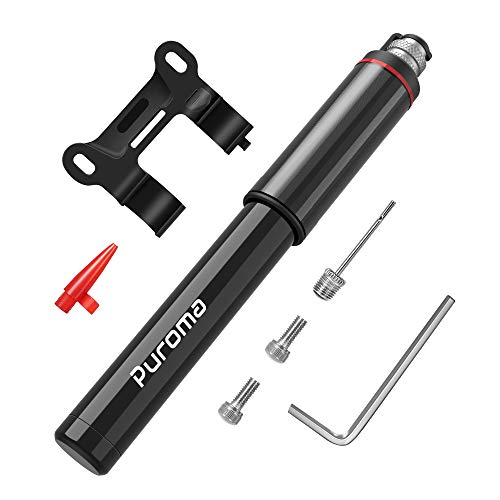
This bike pump is a must-have for any cyclist looking for a durable and efficient inflation tool. Made of aluminum alloy, the pump is highly resistant to corrosion and delivers ultra-precision sealing without any air leakage. It features a threaded valve that is compatible with both Presta and Schrader valves, making it a versatile tool for any bike.
Riders are sure to appreciate the fast inflation and efficient, time-saving design of this pump. With a maximum pressure of 120psi/8.27bar, it can easily inflate bicycle tires, and the pumping stroke is reduced by 30% for easy use. When faced with an emergency during a ride, this pump can solve tire problems in just a few minutes, getting riders back on the road and on their way.
The flexible hose design is another standout feature of this pump. The innovative, flexible hose is stored inside the pump's handle and barrel to maximize compactness. It takes the stress off of the valve stem and attaches securely to ensure no air can escape during inflation. This flexible scalability is convenient for use and storage, making it a versatile tool for any cyclist.
Weighing only 85g, the pump is incredibly lightweight and compact. It is more convenient to carry than a traditional bike pump, and it can be fixed onto the bike using the included mounting bracket or stored easily in a backpack. This makes it a perfect helper for cyclists on the go.
This multi-use air pump is ready to inflate the tires of mountain road bikes and electric bikes anytime and anywhere. It even comes equipped with an air needle and a small valve for inflating sports balls such as basketballs, rugby balls, and footballs, as well as balloons, swimming rings, and toys.
7. Maciek Mini Bike Pump: Performance Pressure With Gauge
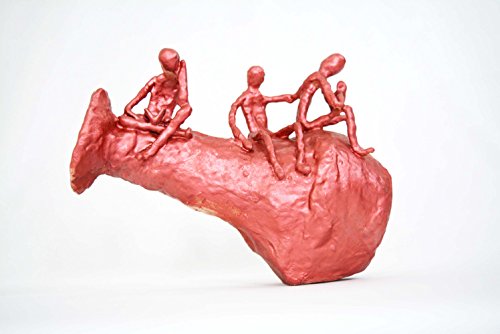
Introducing the Mini Bike Pump with Gauge, from the Le Boss series – a performance pressure pump that guarantees to be your go-to pump for all your inflation needs. The Le Boss Mini Bike Pump is designed to deliver a powerful and efficient performance with its high-grade aluminum barrel that can inflate up to 160 psi (11 bar) with ease.
This mini bike pump is compatible with both Schraeder and Presta valves, making it a versatile option for all your inflatables. The Le Boss Mini Bike Pump also comes with an easy-to-read pressure gauge that allows you to monitor the inflation pressure accurately. This feature helps you to inflate your tires or other inflatables to the perfect pressure level, ensuring you have a smooth and comfortable ride.
The Le Boss Mini Bike Pump is also designed to be compact and lightweight, making it easy to carry in your backpack or mount on your bike frame. The pump comes with a water bottle frame mount with straps that securely attaches to your bike frame, keeping the pump within easy reach. Additionally, the pump also includes a sports ball needle inflator, making it a versatile tool for all your inflation requirements.
8. Pro
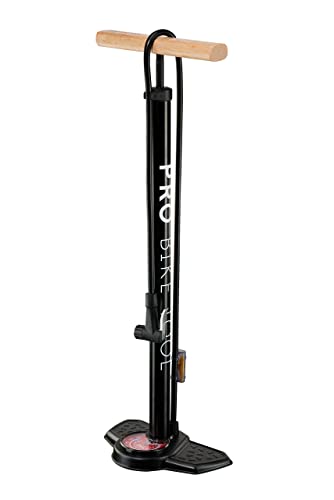
Looking for a reliable and efficient bike pump that won't disappoint? Look no further than the PRO BIKE TOOL Track Style Bike Pump with Gauge!
Equipped with an extra-long hose measuring 1100mm and an oversized piston, this pump delivers incredible pumping power that can inflate high volumes to pressures up to 160 psi / 11 BAR and over with ease. Plus, the ergonomic wooden T-handle provides a comfortable grip and excellent pushing power, making inflation a breeze.
Constructed with a high-tensile steel base and an aluminum pump barrel, this pump is built to last and can handle even the toughest of inflating tasks. And with its secure clamp-on valve connection, you can rest assured that you won't experience any leaky tire inflation.
Not only is this pump reliable and efficient, but it also comes with a ball needle, balloon valve, and Dunlop Valve Adapter to accommodate any additional inflation needs you may have. And with its CNC machined aluminum alloy construction, you're investing in a product that's built to last.
PRO BIKE TOOL is so confident in the quality of their products that they offer a refund or replacement if you experience any issues with your pump. So why wait? Invest in the best and save money in the long run with the PRO BIKE TOOL Track Style Bike Pump with Gauge.
9. Giyo Suspension Pump – Max 300 Psi!
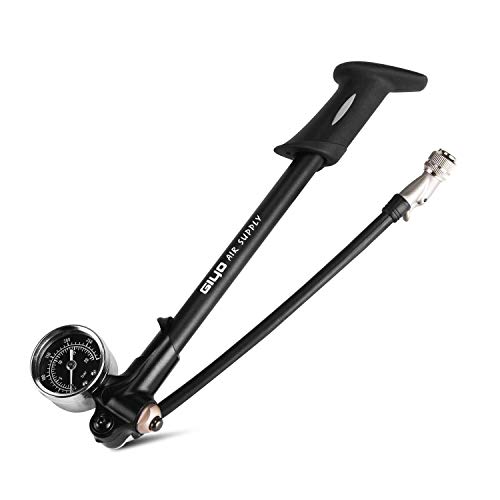
This shock pump is a must-have for experienced mountain bikers who need to inflate their air fork or rear suspension with a Schrader valve. With a maximum pressure of 300psi, this pump is designed to handle the rigors of off-road cycling.
One of the unique features of this pump is its No-Air-Lose nozzle. Unlike other shock pumps that lose a small amount of air when disconnected, this pump has a lever lock on the head that prevents any air loss with proper operation. This means that riders can inflate their suspension to the exact pressure they need for their ride without worrying about losing any air.
The pump is a top-quality product that has been manufactured in Taiwan, a country known for its excellence in cycling products. Many well-known American cycling brands are also manufactured in Taiwan, so customers can be assured of the quality of this product.
It is important to note that some sellers use less expensive modes and similar photos to mislead customers. However, customers can distinguish this pump from others by comparing the handle part. The handle of this pump is made of rubber material and is larger than others made of plastic.
Despite being sold at an extremely low price, this shock pump is of the highest quality and is priced to sell. The seller sometimes even loses money on sales because they want to provide customers with the best value for their money.
10. Mozowo's Smart Mini Bike Pump With Gauge
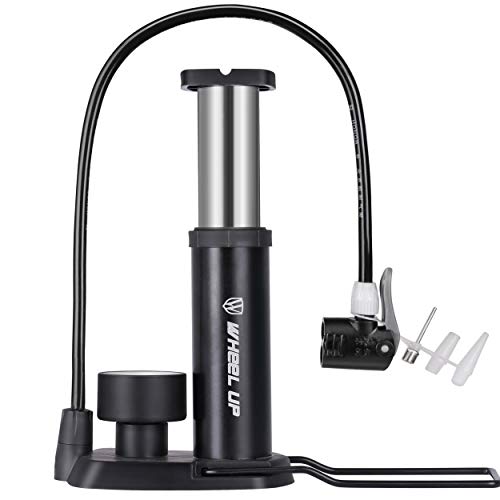
The dual pump head of this bike pump is compatible with both Presta and Schrader valves, making it suitable for all kinds of bikes. It also comes with a sports ball needle and inflation cone for added convenience. The pump is able to inflate tires up to 120 PSI, making it easy to use on road bikes, city bikes, mountain bikes, and more.
Constructed with durable aluminum alloy, this bike pump is both lightweight and compact. It is designed to withstand frequent use and is built to last. The innovative hose design allows for easy switching between Presta and Schrader valves without the need for adapters. The thread-on valve connection also ensures a super tight seal with no air leaks, preventing damage to bike tire valves.
The quality of this bike pump is top-notch, and the manufacturer stands behind their product. If there are any issues with the product, they offer a refund or replacement within 30 days of receiving the item. With its high-quality construction and versatile compatibility, this bike pump is an excellent choice for any cyclist looking for a reliable and efficient way to inflate their tires.
Best Psi For Mountain Bike FAQs
At what point does reducing tire pressure for mountain biking become too low?
Reducing tire pressure for mountain biking has become a popular practice among riders, as it provides various benefits such as increased traction, better shock absorption, and smoother rides. However, there is a point where reducing tire pressure becomes too low, and it can negatively affect your biking experience.
The ideal tire pressure for mountain biking varies depending on different factors such as rider weight, tire width, and trail conditions. Generally, the recommended range for tire pressure is between 20-30 PSI. Going below this range can cause pinch flats, rim damage, and loss of control.
When reducing tire pressure, it's essential to stay within the recommended range for your tire and avoid going too low. If you notice your tire sidewalls bulging or folding during a ride, it's a sign that the pressure is too low. In this case, you should stop and add more air to your tires until they regain their shape.
In conclusion, reducing tire pressure for mountain biking is a great way to enhance your riding experience, but it's important to stay within the recommended range to avoid safety hazards and prevent damage to your bike.
How does tire pressure affect the durability of mountain bike tires?
Tire pressure plays a crucial role in determining the durability and performance of mountain bike tires. The ideal tire pressure for any given mountain bike tire depends on various factors such as rider weight, terrain, and weather conditions. Generally, higher tire pressure results in better rolling efficiency and reduces the risk of pinch flats, but it can also lead to increased wear and tear of the tire.
On the other hand, lower tire pressure provides better traction and shock absorption, but it also increases the risk of punctures and sidewall damage. Therefore, it is essential to maintain the optimal tire pressure for your mountain bike tires to ensure their longevity and performance.
Overinflated tires are more prone to punctures and sidewall damage due to the lack of shock absorption. Underinflated tires, on the other hand, are more susceptible to pinch flats and tire damage due to increased friction with the ground. Therefore, it is crucial to check and adjust the tire pressure regularly to ensure the durability and longevity of your mountain bike tires.
How does tire pressure affect traction on mountain bike trails?
Tire pressure plays a crucial role in the traction of a mountain bike on the trail. The appropriate tire pressure ensures better control, stability, and grip on the terrain. Lower tire pressure increases the contact area between the tire and the ground, providing better traction on rough surfaces and loose terrain. However, excessively low tire pressure can lead to pinch flats and decreased efficiency while pedaling.
On the other hand, higher tire pressure reduces the contact area between the tire and the ground, resulting in reduced traction on slippery surfaces. It can also cause the tire to bounce off obstacles, making it difficult to maintain control. Additionally, it can lead to a harsh ride experience, causing discomfort to the rider.
Therefore, it is essential to maintain the correct tire pressure based on the terrain and rider's weight to ensure optimal traction and control while riding on mountain bike trails. A pressure gauge can be used to measure and adjust the tire pressure accordingly. It is recommended to consult the bike manufacturer's guidelines or a professional bike mechanic for recommendations on tire pressure for the specific bike and terrain.
How does tire width impact recommended psi for mountain bike tires?
The recommended psi for mountain bike tires is affected by a variety of factors, including tire width. Generally, wider tires require lower psi than narrower tires. This is because wider tires have a larger contact patch with the ground, which means they can distribute the rider's weight more evenly and provide better traction. Lower psi also allows the tire to conform to the terrain, absorbing shocks and vibrations. However, it's important to note that the rider's weight, riding style, and terrain also play a role in determining the recommended psi. For example, a heavier rider may need to increase psi to prevent pinch flats, while a rider on rocky terrain may want to decrease psi for better grip. It's always a good idea to consult with a professional or do some research to determine the best psi for your specific bike, tires, and riding conditions.
Is there a difference in recommended psi for front and rear mountain bike tires?
Yes, there is a difference in the recommended psi for front and rear mountain bike tires. The recommended psi for front and rear mountain bike tires varies depending on the rider's weight, the terrain, and the tire size.
In general, the front tire should have a slightly lower psi than the rear tire. This is because the front tire is responsible for absorbing impacts and providing traction, whereas the rear tire is responsible for providing power and stability.
A good starting point for psi recommendations is to use the manufacturer's guidelines, which can be found on the sidewall of the tire. However, it's important to adjust the psi based on personal preference and riding conditions. For example, if you're riding on a rough and rocky trail, you may want to lower the psi to improve traction and absorb shocks. On the other hand, if you're riding on smooth and hard-packed terrain, you may want to increase the psi for better efficiency and speed.
Ultimately, finding the right psi for your mountain bike tires is a matter of experimentation and finding what works best for you and your riding style.
Should tire pressure be adjusted based on rider weight for mountain biking?
Yes, tire pressure should be adjusted based on rider weight for mountain biking. This is because the weight of the rider affects the amount of pressure that the tire needs to support the bike and provide optimal performance. If the tire pressure is too high, it can cause the bike to bounce around and reduce traction, which can be dangerous on rough terrain. On the other hand, if the tire pressure is too low, it can cause the tire to deform and increase rolling resistance, which can make it harder to ride and decrease efficiency.
To determine the ideal tire pressure for mountain biking, riders should consider their weight, the type of terrain they will be riding on, and the width of their tires. Generally, heavier riders will need more tire pressure to support their weight, while lighter riders will need less. Additionally, riders should adjust tire pressure based on the terrain they will be riding on, with lower pressure being better for loose or muddy terrain and higher pressure being better for hard-packed or rocky terrain. Overall, adjusting tire pressure based on rider weight is an important part of optimizing performance and safety while mountain biking.
What are the benefits of running lower psi for mountain bike tires?
Running lower psi for mountain bike tires can provide several benefits. Firstly, lower psi can improve traction on rough and loose terrain. This is because the tire can better conform to the ground, allowing for more surface area to make contact and providing more grip. Secondly, lower psi can also improve comfort while riding. The tire can absorb more shock and vibrations, reducing the impact on the rider's body. Thirdly, lower psi can help to prevent flats. When the tire is at a higher psi, it is more likely to puncture or pinch flat on sharp objects. Lower psi can help the tire absorb the impact and reduce the risk of flatting. However, it is important to note that running too low psi can also have negative effects, such as decreased efficiency and increased rolling resistance. It is recommended to experiment with different psi levels to find the optimal balance between traction, comfort, and efficiency for individual riding preferences and terrain.
What is the ideal psi for tubeless mountain bike tires?
The ideal psi, or pounds per square inch, for tubeless mountain bike tires varies depending on a number of factors, including rider weight, tire width, and trail conditions. However, as a general rule of thumb, most tubeless mountain bike tires perform best at a psi range of 22-28. This range provides enough pressure to keep the tire from bottoming out on rough terrain, while still allowing for adequate traction and shock absorption. It's worth noting that some riders may prefer slightly higher or lower psi depending on their personal preferences and riding style. Ultimately, finding the ideal psi for your tubeless mountain bike tires requires a bit of experimentation and fine-tuning to achieve the perfect balance of performance and comfort.
What is the impact of psi on rolling resistance for mountain bike tires?
Psi, or pounds per square inch, has a significant impact on rolling resistance for mountain bike tires. Rolling resistance is the force required to keep a tire rolling at a steady speed on a surface. When the tire pressure is too low, the contact patch between the tire and the ground increases, creating more friction and increasing rolling resistance. On the other hand, when the tire pressure is too high, the contact patch decreases, reducing the tire's ability to conform to the surface, which can also increase rolling resistance.
Finding the optimal psi for mountain bike tires depends on various factors, such as the rider's weight, the terrain, and the tire's width. Generally, a higher psi is recommended for smoother surfaces and heavier riders, while a lower psi is suitable for rougher terrains and lighter riders. It is essential to find the right balance between low rolling resistance and sufficient traction to ensure a comfortable and efficient ride.
What is the optimal psi range for mountain bike tires?
The optimal psi range for mountain bike tires depends on various factors such as rider weight, terrain, and tire width. As a general rule, the recommended psi range for mountain bike tires is between 25-35 psi for most riders and conditions. However, heavier riders or those riding on rough or rocky terrain may require higher psi to prevent pinch flats or rim damage. On the other hand, lighter riders or those riding on smoother trails may benefit from lower psi for better traction and comfort. It's also important to consider the tire width as wider tires can handle lower psi while narrower tires require higher psi. Ultimately, finding the optimal psi range for your mountain bike tires requires some experimentation and adjustments based on your individual needs and preferences. Regularly checking and maintaining proper tire pressure is essential for optimal performance and safety on the trails.







